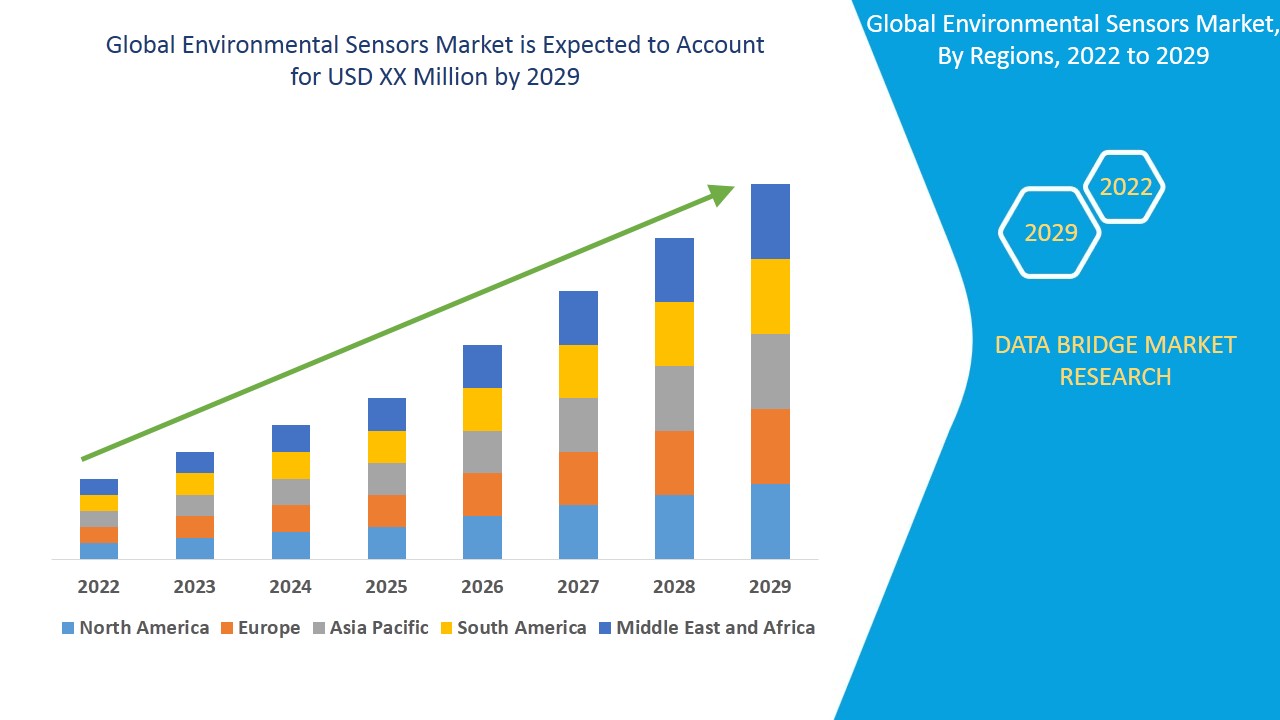Global Environmental Sensor Market
市场规模(十亿美元)
CAGR :
% 
 USD
287.00 Billion
USD
525.00 Billion
2023
2031
USD
287.00 Billion
USD
525.00 Billion
2023
2031
| 2024 –2031 | |
| USD 287.00 Billion | |
| USD 525.00 Billion | |
|
|
|
|
2023 年全球环境传感器市场价值为 2870 亿美元。预计市场规模将以 11.90% 的复合年增长率增长,到 2031 年达到 5250 亿美元。
环境传感器市场概况
环境传感器市场有助于跟踪和管理周围环境的健康状况。环境传感器通过提供实时数据来测量空气质量、水纯度和土壤条件等关键因素,这些数据可指导决策并确保遵守法规。例如,空气质量传感器可识别污染物和颗粒物,有助于保护公众健康。水质传感器可检测饮用水中的污染物,确保其安全。这些传感器的数据支持环境评估和可持续管理实践。将这些传感器与物联网 (IoT) 技术相结合,可创建一个互联系统,提高我们监测和应对环境变化的能力,从而更好地保护环境和公众健康。
数据桥市场研究市场报告提供了最新发展、贸易法规、市场份额、基于细分和区域分析的市场趋势、市场参与者的影响、新兴收入领域机会分析、市场法规、战略市场增长分析、市场规模、类别市场增长、应用领域和主导地位、产品批准、产品发布、地理扩展和市场技术创新的详细信息。要获取有关市场的更多信息,请联系数据桥市场研究的专家分析师团队。我们的团队将帮助您做出明智的市场决策,以实现业务增长。
全球环境传感器市场规模
|
环境传感器市场报告指标详情 |
|
|
预测期 |
2024-2031 |
|
基准年 |
2023 |
|
历史年份 |
2022(可定制 2016-2021) |
|
測量單元 |
十亿美元 |
|
数据指针 |
除了对市场价值、增长率、细分、地理覆盖范围和主要参与者等市场情景的见解之外,Data Bridge Market Research 策划的市场报告还包括深入的专家分析、按地理位置表示的公司生产和产能、分销商和合作伙伴的网络布局、详细和更新的价格趋势分析以及供应链和需求的赤字分析。 |
环境传感器技术的多功能性得益于传感器设计、数据处理能力以及物联网 (IoT) 和人工智能 (AI) 等新兴技术的集成方面的进步,从而推动了市场的增长。Databridge Market Research 深入全面分析了市场,并发现全球环境传感器市场正以 11.90% 的复合年增长率增长。2023 年市场规模为 2870 亿美元,预计到 2031 年将增长至 5250 亿美元。环境传感器除了测量天气外还有多种应用。它用于森林火灾探测、智能家居和建筑、医疗设施、自然灾害监测等多个行业。
全球环境传感器市场动态
环境传感器市场增长动力
智能家居和建筑对环境传感器的需求很高
在住宅和商业建筑中,环境传感器在提高舒适度和确保高效利用能源方面发挥着重要作用。这些传感器持续监测各种参数,如温度、湿度和光照水平,从而实现实时数据收集。这些数据允许根据当前条件自动调整暖通空调系统和照明,从而优化能源使用。环境传感器有助于显著节约能源并降低运营成本。此外,它们通过保持理想的环境条件来提高居住者的舒适度。因此,对节能和智能建筑解决方案的不断增长的需求推动了环境传感器市场的扩张。
智能恒温器、节能电器和先进照明系统等智能家居技术的兴起反映了人们对可持续性的日益重视。环境传感器在这方面发挥着至关重要的作用,它提供有关能源使用和空气质量的实时数据,从而使房主能够做出明智的决定,进一步减少对环境的影响并提高能源节约。
环境意识提升了环境传感器的使用
随着个人和组织越来越意识到其对生态的影响,环保意识大大推动了对环境传感器的需求。这些传感器用于监测和分析各种环境安全参数。随着公众对气候变化、污染和资源枯竭的担忧日益加深,对准确数据的需求也日益增加,以便做出明智的决策和遵守法规。这种意识的增强推动了制造业、农业和城市规划等各行各业采用先进的传感器,以提高可持续性并减轻环境风险。
更严格的污染法规要求使用环境传感器
严格的政府法规旨在减少污染并确保遵守环境标准。严格遵守这些严格的法规和准则以改善空气和水质的需求增加了对先进环境监测传感器的需求。例如,印度的国家清洁空气计划以及韩国和日本的各种清洁空气法案正在推动各行各业实施复杂的传感器系统。这些法规要求对环境进行准确和持续的监测以确保遵守法规,从而导致不同行业对环境传感器的采用激增。
环境传感器在消费电子产品中的应用
将先进的环境传感器集成到消费电子产品(如智能家居设备、可穿戴设备和个人健康监测器)中的迫切需求极大地推动了环境传感器市场的发展。随着消费者越来越意识到环境对其健康的影响,这种趋势在很大程度上受到日益增长的健康和安全问题的推动。制造商通过将监测空气质量、温度、湿度和其他环境因素的传感器集成到其产品中来满足这一需求。这种集成允许实时监控和数据收集,增强用户体验并促进更健康的生活环境。由于这些技术越来越多地融入各种消费电子产品,环境传感器市场预计将迅速扩张。
例如,最新一代空气质量传感器符合将先进环境传感器集成到消费电子产品中的日益增长的趋势。这些传感器旨在监测关键的空气质量因素,以应对消费者日益增长的健康和安全问题。这种发展反映了智能家居设备和可穿戴设备对实时环境监测的更广泛市场需求,增强了用户体验并促进了更健康的生活环境。
环境传感器市场增长机会
环境传感器市场将迎来大幅增长,因为它对热舒适度和居住者满意度的影响越来越大。这些传感器通过提供 HVAC 调节的实时数据来提高舒适度和生产力,在维持最佳室内环境中发挥着至关重要的作用。纳米技术与这些传感器的集成进一步提高了它们的功能,可以在微观层面上更精确地检测和分析空气质量和其他关键因素。随着传感器变得越来越复杂并被纳入智能建筑系统,它们能够对不断变化的条件做出自动化、智能化的响应,从而提高能源效率和整体居住者舒适度。先进技术与智能管理岗位的融合将极大地促进未来几年环境传感器市场的扩张。
环境传感器市场规模增长挑战
由于条件恶劣、成本高昂和预算限制,环境传感器市场面临巨大挑战。在偏远地区安装传感器通常需要应对极端天气和复杂地形,这使部署和维护变得复杂。这些环境可能会使传感器暴露在极端温度、湿度和腐蚀性物质中,从而对其使用寿命和准确性产生不利影响。此外,在具有挑战性的地点部署和维护这些传感器的高成本可能会阻碍投资并限制传感器网络的可扩展性。同时,预算限制也阻碍了可以缓解这些问题的先进无线或基于物联网的传感器技术的采用。这创造了一个充满挑战的局面,即对偏远地区可靠监控的需求与财务限制和维护复杂传感器系统的复杂性相冲突。
环境传感器市场规模增长制约因素
环境传感器市场面临巨大的增长制约因素,这主要是由于极端温度对传感器性能和寿命的不利影响。在恶劣条件下运行的传感器,尤其是暴露在超过 105°C 温度下的传感器,其使用寿命会缩短至正常条件下预期使用寿命的 34%,从而加速退化。使用寿命的大幅缩短引发了人们对可靠性的担忧,并可能限制潜在用户投资环境传感器,迫使他们寻求被认为更可靠的替代品。此外,许多应用需要持续监控,这可能会进一步降低传感器的效率。例如,嵌入混凝土结构或土壤中的传感器必须承受温度波动和机械应力,这会导致过早失效或传感器读数发生显著变化。这需要频繁更换或重新校准,从而增加运营成本并使维护工作复杂化。这些因素影响整体可行性和扩展潜力,从而限制环境传感器市场的增长机会。
环境传感器市场范围和趋势
|
环境传感器市场细分概述 |
|
|
段类型 |
子段 |
|
产品 |
固定式和便携式 |
|
类型 |
温度、湿度、空气质量、水质、综合、气体、化学物质、烟雾、紫外线 (UV) 和土壤湿度 |
|
地点 |
室内、室外和便携式 |
|
垂直的 |
政府、商业、工业、住宅、医疗保健、消费者和企业 |
- 集成传感器系统结合了温度、pH、浊度以及各种离子或化合物的存在等多种传感器,可以全面了解水质。
- 新型传感器系统结合了多种环境传感器,用于测量湿度、检测一氧化碳和评估颗粒物水平。这些系统通常具有相对较高的准确率。
- 固定传感器被研究人员广泛用于详细观察,并被集成到公共供水系统中,以实现高效的监测和控制。
- 随着企业采用环保做法并投资传感器技术来监测和减少碳足迹,商业领域预计将占据最大的份额。
- 紫外线传感器非常适合户外环境监测,因为它的设计可承受雨雪等恶劣天气条件,确保耐用性和可靠性。其高度安全性使其能够有效测量紫外线辐射,而不会影响各种环境条件下的性能。
环境传感器市场区域分析 – 市场趋势
|
环境传感器市场区域概览 |
|
|
区域 |
国家 |
|
欧洲 |
德国、法国、英国、荷兰、瑞士、比利时、俄罗斯、意大利、西班牙、土耳其、欧洲其他地区 |
|
亚太地区 |
中国、日本、印度、韩国、新加坡、马来西亚、澳大利亚、泰国、印度尼西亚、菲律宾、亚太地区其他地区 |
|
北美 |
美国、加拿大和墨西哥 |
|
中东及非洲 |
沙特阿拉伯、阿联酋、南非、埃及、以色列、中东其他地区和非洲 |
|
南美洲 |
巴西、阿根廷和南美洲其他地区 |
关键见解
- 由于业务的扩张,北美占据了市场主导地位,导致对用于监测和控制工业排放和环境影响的环境传感器技术的需求很高。
- 北美严格的环境法规和标准需要先进的传感器来确保合规并减少污染。
- 在北美,由于美国政府最终将增加对污染控制和环境监测的资金投入,从而鼓励采用先进的环境传感器,预计美国将拥有最高的市场份额。
- 美国环保署为美国救援计划拨款 5000 万美元用于加强空气质量监测,这直接促进了环境传感器市场的发展,增加了对先进空气质量传感器的需求。
- 不断加大力度发展环保型产业和可持续发展,推动了对精确环境传感器的需求。
- 亚太地区被公认为全球增长最快的经济地区,其中印度、印度尼西亚和菲律宾等国家做出了重大贡献,由于出口和本地需求的增长,这些国家的增长水平超过了疫情之前。
- 亚太地区占世界总人口的60%,且拥有70%以上的城市,该地区城镇化的快速发展推动了环境传感器市场的大幅增长。
- 自21世纪初以来,亚太地区的城市化扩张和近10亿人摆脱极端贫困,增加了对空气质量安全、水污染和整体环境健康监测的需求,以维持城市宜居性和公众健康。
全球环境传感器市场领先企业
- Sensirion AG(瑞士)
- 欧姆龙株式会社(日本)
- 西门子(德国)
- 德州仪器公司(美国)
- 力登公司 (美国)
- ams AG(奥地利)
- Bosch Sensortec GmbH(德国)
- 施耐德电气(法国)
- 安费诺 (美国)
- 意法半导体(瑞士)
- 瑞萨电子株式会社(日本)
- AVTECH Software, Inc.(美国)
- ADI 公司(美国)
- Apogee Instruments, Inc.(美国)
- TE Connectivity (瑞士)
- 洛克希德·马丁公司(美国)
- Gems Sensors, Inc.(美国)
- NuWave 传感器技术有限公司 (爱尔兰)
- eLichens(法国)
- 安捷伦科技公司(美国)
- 伊顿(爱尔兰)
- Oizom Instruments Pvt. Ltd.(印度)
- Air-Met Scientific Pty Ltd.(澳大利亚)
- Ecotech(澳大利亚)
- Breeze Technologies(德国)
环境传感器市场的最新发展
- 2023 年 9 月,Sensirion AG 推出了 SEN54 和 SEN55 环境传感器,它们集成在 Grove 的一体化传感器中。这些传感器旨在监测室内空气质量,适用于 HVAC 系统和其他应用。
- 2023 年 1 月,Bosch Sensortec 开发出全球最小的 PM2.5 空气质量传感器 BMV080。该传感器针对紧凑型物联网设备进行了优化,可提供可靠、免维护的颗粒物监测。
- 2023 年 1 月,Bosch Sensortec 还创造了一种新型液体凝胶涂层气压传感器,旨在在恶劣的水条件下可靠运行。这项创新增强了传感器在具有挑战性的环境中耐用性和性能。
- 2022 年 9 月,Sensirion 宣布推出专为汽车应用量身定制的数字温度传感器系列 STS4xA。该传感器平台支持自动光学检测,并包含先进的车载诊断系统,增强了其在苛刻的汽车环境中的可靠性和功能性。
- 2022 年 4 月,AMS 推出了一款绿色激光二极管,它为红色激光提供了更明亮、更用户友好、更可靠且更具成本效益的替代方案。它适用于调平、扫描、生物科学和点投影等应用,可在各种光学解决方案中提供更好的性能和多功能性。
- 2021 年 10 月,ABB 推出了全球首款免接触式环境智能传感器 FusionAir 智能传感器,用于对抗室内污染。该传感器提供四种检测选项,可改善室内空气质量、安全性和舒适度。世界卫生组织已将室内空气污染确定为主要的环境健康威胁,室内空气污染平均比室外空气严重 3.5 倍。
- 2021 年 5 月,Sensirion 与 Burnon International 合作,允许 Burnon 在中国分销 Sensirion 的传感技术。此举旨在扩大 Sensirion 的市场影响力并利用 Burnon 的本地分销网络。
- 2021年3月,博世传感器技术公司推出了BME688,这是一款集成气体、湿度、温度和气压检测的紧凑型四合一空气质量传感器。它还采用了先进的AI技术,增强了其监测和评估空气质量的能力。
- 2021 年 1 月,匹兹堡国际机场与霍尼韦尔合作,在机场创新中心 xBridge 测试空气质量增强技术。霍尼韦尔的健康建筑平台将用于监测空气质量,测量温度、湿度、二氧化碳、颗粒物和挥发性有机化合物 (VOC),以改善室内空气质量。
DBMR 的环境传感器市场报告将为您提供宝贵的见解,这些见解有助于您做出多项重要的业务决策。根据我们的报告和研究专业知识,您可以为您的业务制定切实可行的增长战略。
SKU-
Get online access to the report on the World's First Market Intelligence Cloud
- Interactive Data Analysis Dashboard
- Company Analysis Dashboard for high growth potential opportunities
- Research Analyst Access for customization & queries
- Competitor Analysis with Interactive dashboard
- Latest News, Updates & Trend analysis
- Harness the Power of Benchmark Analysis for Comprehensive Competitor Tracking
研究方法
数据收集和基准年分析是使用具有大样本量的数据收集模块完成的。该阶段包括通过各种来源和策略获取市场信息或相关数据。它包括提前检查和规划从过去获得的所有数据。它同样包括检查不同信息源中出现的信息不一致。使用市场统计和连贯模型分析和估计市场数据。此外,市场份额分析和关键趋势分析是市场报告中的主要成功因素。要了解更多信息,请请求分析师致电或下拉您的询问。
DBMR 研究团队使用的关键研究方法是数据三角测量,其中包括数据挖掘、数据变量对市场影响的分析和主要(行业专家)验证。数据模型包括供应商定位网格、市场时间线分析、市场概览和指南、公司定位网格、专利分析、定价分析、公司市场份额分析、测量标准、全球与区域和供应商份额分析。要了解有关研究方法的更多信息,请向我们的行业专家咨询。
可定制
Data Bridge Market Research 是高级形成性研究领域的领导者。我们为向现有和新客户提供符合其目标的数据和分析而感到自豪。报告可定制,包括目标品牌的价格趋势分析、了解其他国家的市场(索取国家列表)、临床试验结果数据、文献综述、翻新市场和产品基础分析。目标竞争对手的市场分析可以从基于技术的分析到市场组合策略进行分析。我们可以按照您所需的格式和数据样式添加您需要的任意数量的竞争对手数据。我们的分析师团队还可以为您提供原始 Excel 文件数据透视表(事实手册)中的数据,或者可以帮助您根据报告中的数据集创建演示文稿。














